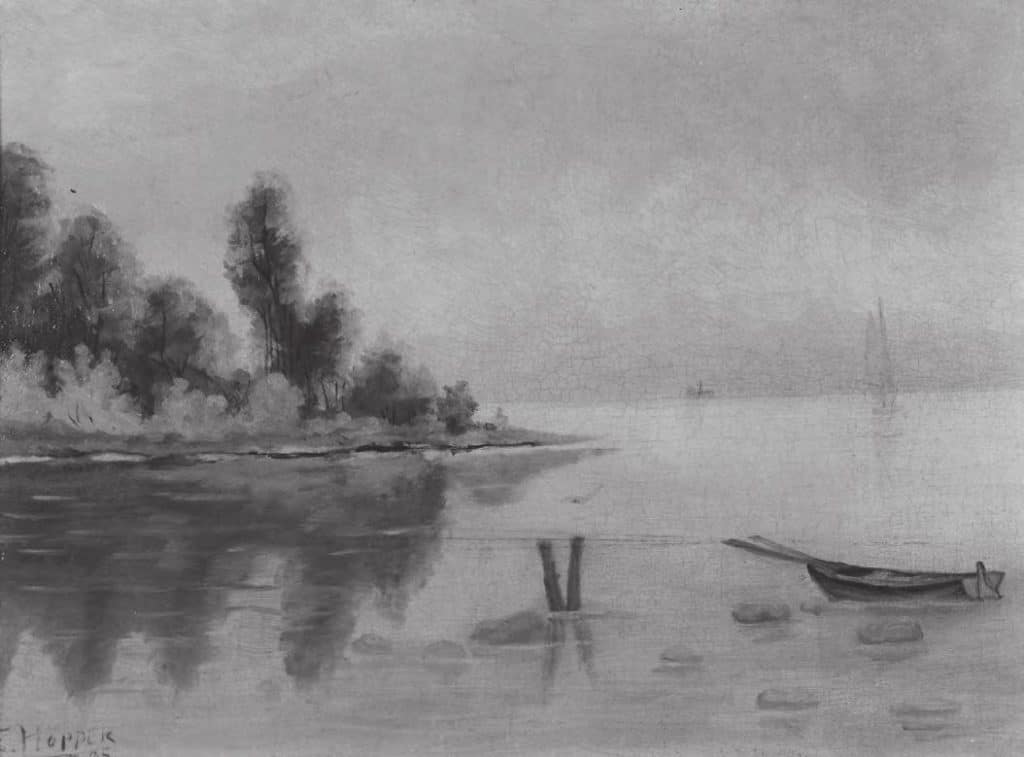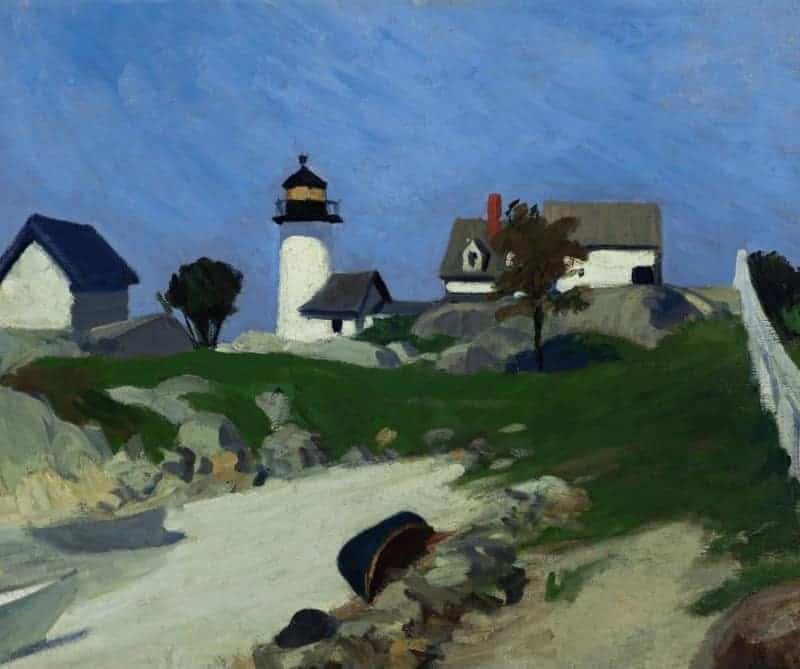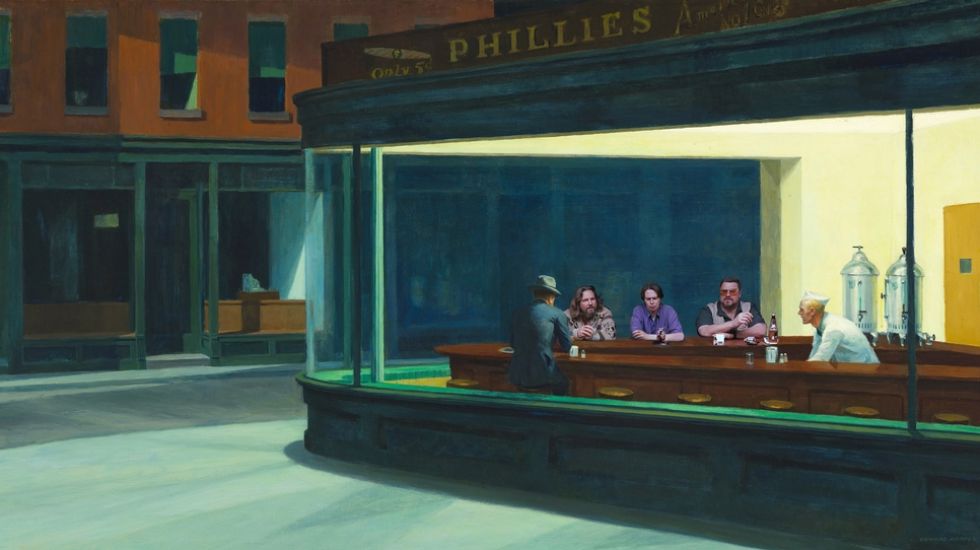Edward Hopper was a New York-based American realist painter and printmaker best known for his oil paintings, particularly those involving seascapes and rural landscapes, as well as those depicting scenes of quotidian America life and the people living in it. He largely focused on quiet moments devoid of action, and he was known as an introverted, well-read, conservative man. Many of these quiet moments have at the heart of them the subject of a solitary woman, who often appears ambiguously lonely.
Edward Hopper's formative years
Hopper was born in 1882 to a middle-class family in Nyack, New York, just north of New York City. His father, Garret Henry Hopper, was a dry goods merchant, and his mother, Elizabeth Griffiths Smith, had a considerable inheritance through which his parents led a comfortable life. At the age of five, Hopper began to demonstrate a talent for drawing, which his parents encouraged by keeping him well stocked with art supplies.
He created his first painting, Rowboat in Rocky Cove, in 1895, which hinted at his emerging interest in nautical themes.

Rowboat in rocky cove, here identified as Lake view, after an unknown artist, by Edward Hopper. 1895. Oil on canvas, 25.4 by 34.9 cm. (Private collection; photograph Frick Art Reference Library, New York)
He started painting self-portraits as a teenager, a subject that would endure through his students years, and much of his career as an artist.
Hopper studied for six years at the New York Institute of Art and Design, Where he had two influential teachers. Under the tutelage of William Merritt Chase, Hopper studied oil painting, and in those days he emulated Chase's style, as well as that of French painters like Manet and Degas. The other teacher who had a marked effect on him was the artist Robert Henri, who taught "life class"- a course focused on drawing the human figure-at the institute. Henri suggested that his students try to impart a contemporary spirit in their work. The first painting of Hopper to depict the interior for which he later became famous was Solitary Figure in a Theater (ca. 1904).
Edward took part-time work with an advertising agency starting in 1905. The job entailed designing covers for trade magazines. Although he would continually turn to illustration gigs until the mid-1920s to fulfill economic obligations, it led him to loath that type of work.
During that artistically unfulfilling time, however, Hopper made three trips to Europe, each of which was anchored in Paris. He seemingly went to observe the creative zeitgeist of the city, but in reality Hopper studied alone and later claimed to have remained virtually unaffected by everyone in that scene save Rembrandt, and French engraver Charles Méryon. Hopper imitated the latter's sullen depiction of Parisian life.
Hopper's struggle with anonymity
Hooper rented a studio in New York City after his last trip to Europe. Grappling with his own style, he was forced to return to freelance illustration work, which required relentless solicitation. He fell into frequent periods of depression, and his painting suffered for it. In 1912, however, Hopper got a change of scenery in Gloucester, Massachusetts, where he was inspired to do his first outdoor paintings in America, including Squam Light, which was his maiden lighthouse painting. That particular work set the stage for many more to follow.

Hopper, Squam Lights 1912
Edward Hopper sold his first painting, Sailing, at the Armory Show in 1913, at the age of thirty-one. Unfortunately, his career did not take off then has he had hoped, and wouldn't until many years later. Soon after, Hopper moved to Greenwich Village, where he would remain for the rest of his life.
In 1915, Hopper turned to etching. He produced about seventy works in this vein, the bulk of which depicted urban scenes of Paris and New York, but this medium didn't receive much attention until the 1920s. In the early '20s, however, two of Hopper's most remarkable works were not etchings but a pair of paintings: New York Interior (1921) and New York Restaurant (1922). Two other paintings that he did during this time - Girl at Sewing Machine and Moonlight Interior - belong to what would later be considered his "window" paintings. In each of these, a figure, usually a female, is near or looking out a window of an apartment or view from the outside looking in.
While Hopper is best known for his oil paintings, his watercolors and etchings have received substantial attention as well. The sketches found in his notebooks are also of excellent quality, but they were never intended for public display. The way Hopper utilized light and shadow effects to create mood in many of his works, such as Early Sunday Morning (1930), Summertime (1943), and Sun in an Empty Room (1963), has often been linked to the cinematographic techniques used in film noir.— Mediums and Methods
Hopper's breakthrough and rise to fame
In 1923, thanks to his wife, model, and lifetime companion, Josephine Nivison, six watercolors that Hopper painted in Gloucester were admitted to an exhibit at the Brooklyn Museum. Although Nivison was also an artist and a former student of Robert Henri, she put aside her own artistic aspirations and joined her husband in his hermitic lifestyle.
Hopper was especially prolific during the 1930s and early '40s. In fact, he even thrived during the Great Depression. In 1931, he sold thirty paintings. Several major museums, including the Whitney Museum of American Art and the Metropolitan Museum of Art, paid thousands of dollars for Hopper's works, and his status as an artist was bolstered as a result.
In 1933, Hopper was granted his first large-scale retrospective at the Museum of Modern Art, and the following year the Hoppers built a summer house in South Truro, Massachusetts. They spent the rest of their lives alternating between their modest flat in the village and their home on Cape Cod.
Famous works
One of Hopper's most celebrated works is Automat (1927), which depicts a lone woman gazing into a coffee cup at a diner at night. Another, Chop Suey (1929), also depicts the female subject in a public interior, but there is a pair of women talking at the café rather than one. Nighthawks (1942) once again takes the subject of a community interior, but is painted from the perspective of someone outside. In Office in a Small City (1953), Hopper depicts a man sitting in a corner office, ostensibly surveying the cityscape that lies beyond his window.

